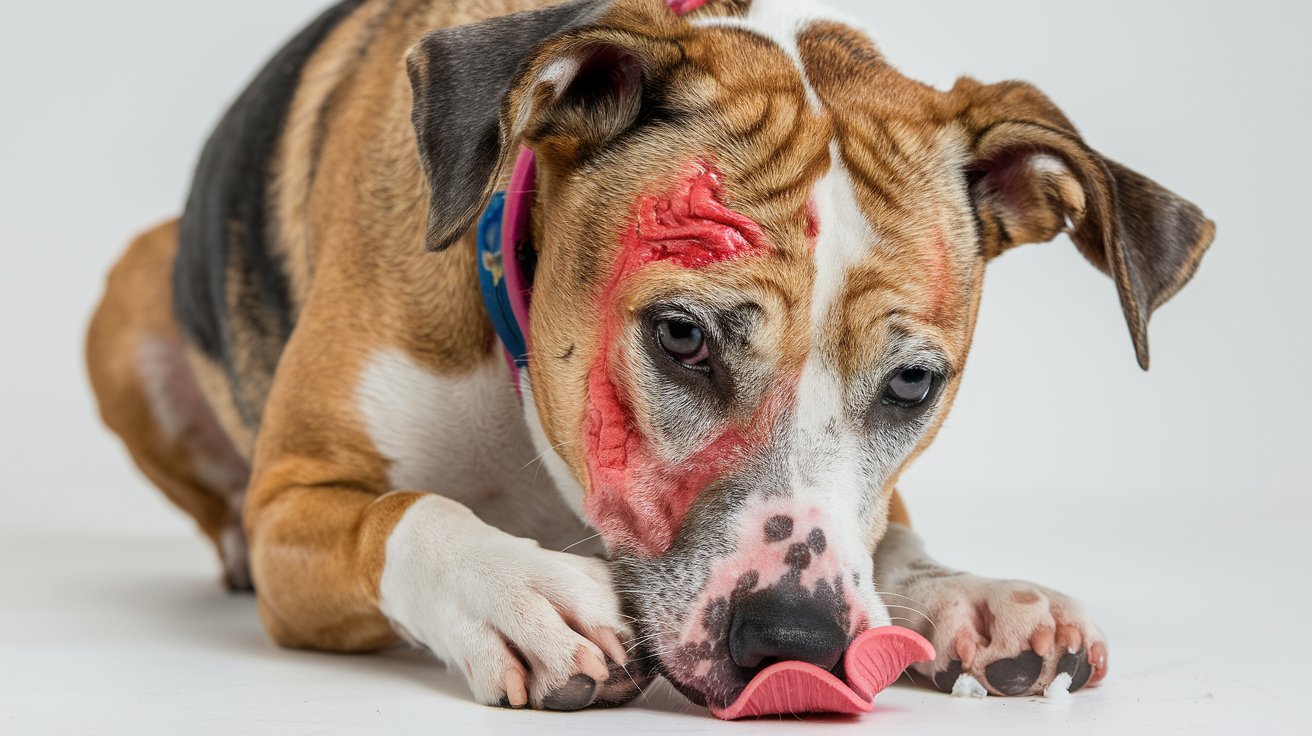Atopic Dermatitis in Dogs: 100% Symptoms, Causes, & Powerful Treatments
Atopic dermatitis in dogs, often referred to as canine atopy, is a chronic, inflammatory skin disease caused by environmental allergens like pollen, dust mites, mold, or grass. Similar to allergies in humans, it can cause severe discomfort and affect a dog’s quality of life. Understanding the symptoms, causes, and available treatments can help dog owners better manage this condition and ensure their pets lead a more comfortable life.
Table of Contents
ToggleWhat is Atopic Dermatitis?

Atopic dermatitis is a genetic predisposition to developing allergic reactions. It’s one of the most common allergic skin diseases in dogs and can develop as early as six months of age, though symptoms may appear later. This condition is not just an annoyance for dogs; it can lead to chronic discomfort, infections, and secondary health problems if left untreated.
Many breeds are prone to developing atopic dermatitis, including:
- Golden Retrievers
- Boxers
- Dalmatians
- West Highland White Terriers
- Bulldogs
- Labradors
However, any breed can be affected, and it is essential to be vigilant about your dog’s health regardless of their genetic predisposition.
Symptoms of Atopic Dermatitis in Dogs
Identifying the symptoms of atopic dermatitis can be tricky, as they are often mistaken for other skin issues. Common signs include:
- Itching and Scratching: The most telltale symptom is persistent scratching, especially around the face, paws, belly, and armpits. Some dogs may scratch so intensely that they cause skin damage.
- Red or Inflamed Skin: Areas of the skin may become red and inflamed due to constant scratching, licking, or chewing.
- Hair Loss: As a result of excessive licking or scratching, dogs can experience localized hair loss.
- Ear Infections: Chronic ear infections are a common symptom of atopic dermatitis, especially in breeds prone to ear issues like Cocker Spaniels and Bulldogs.
- Licking Paws: If your dog constantly licks their paws, it could be a sign of atopy. Allergens from the environment often affect the paws since dogs walk on various surfaces outdoors.
- Sores or Hot Spots: Open sores or “hot spots” develop when a dog bites or scratches one area repeatedly, leading to raw, irritated skin.
Personal Anecdote: Spot’s Constant Itching
A few years ago, my Golden Retriever, Spot, started itching incessantly. At first, we thought it was due to fleas or a minor skin infection, but the scratching persisted even after we treated him for fleas. His paws were red from licking, and bald patches appeared on his belly. After visiting our vet, we found out that Spot had atopic dermatitis, triggered by seasonal pollen. Spot’s diagnosis was both a relief and a new challenge—we had an explanation, but now we had to manage his allergies long-term.
Causes of Atopic Dermatitis in Dogs

Atopic dermatitis in dogs is often triggered by environmental allergens. These can vary from dog to dog, but the most common triggers include:
- Pollen: Seasonal pollen from trees, grasses, and weeds is a significant cause of allergies in dogs.
- Dust Mites: Dust mites thrive in carpets, bedding, and upholstered furniture, making them a common indoor allergen.
- Mold: Mold spores, especially in damp environments, can trigger allergic reactions in sensitive dogs.
- Dander: Although it may seem counterintuitive, some dogs are allergic to human dander or other animals’ dander.
- Food Allergies: While atopic dermatitis is typically linked to environmental factors, certain food allergies can also contribute to skin problems.
Diagnosis of Atopic Dermatitis
Diagnosing atopic dermatitis in dogs can be complicated because it shares symptoms with other conditions like flea allergies, food allergies, or bacterial infections. A veterinarian may start by ruling out these other conditions through flea control treatments or dietary elimination trials.
The most definitive way to diagnose atopic dermatitis is through intradermal allergy testing or blood testing. In intradermal testing, small amounts of different allergens are injected into your dog’s skin to see which ones trigger a reaction. Blood tests, on the other hand, measure the levels of specific antibodies in response to allergens.
Once diagnosed, treatment options can be explored to reduce your dog’s symptoms and improve their quality of life.
Treatment Options for Atopic Dermatitis

Managing atopic dermatitis can be challenging, especially since it’s a lifelong condition. Treatment focuses on relieving the symptoms and minimizing exposure to allergens. Here are the most effective options:
1. Antihistamines and Steroids
Antihistamines can help reduce itching, though they are more effective in some dogs than others. Steroids, like prednisone, are often prescribed for severe flare-ups, but long-term use should be avoided due to potential side effects like weight gain, increased thirst, and diabetes.
2. Immunotherapy (Allergy Shots)
If your dog’s allergens have been identified, immunotherapy (allergy shots) may be an effective long-term solution. This treatment involves giving your dog small doses of the allergens that cause their symptoms, gradually desensitizing their immune system. Over time, the severity of their allergic reactions may decrease.
3. Medicated Shampoos and Conditioners
Bathing your dog with medicated shampoos can help remove allergens from their coat and skin while soothing inflammation. Look for shampoos containing ingredients like oatmeal, aloe vera, or hydrocortisone, which are known for their calming properties.
4. Omega-3 Fatty Acid Supplements
Adding omega-3 fatty acids to your dog’s diet can improve skin health and reduce inflammation. Fish oil supplements are a popular choice for dogs with skin conditions, and many commercial dog foods are fortified with these beneficial fatty acids.
5. Topical Treatments
Topical treatments such as corticosteroid creams and sprays can provide localized relief from itching and inflammation. These treatments are useful for managing flare-ups but should be used under veterinary guidance to prevent overuse.
6. Cytopoint and Apoquel
Two newer medications, Cytopoint and Apoquel, have revolutionized the treatment of atopic dermatitis in dogs. Cytopoint is an injectable medication that blocks the signals that trigger itching, while Apoquel is an oral medication that targets the immune system to reduce allergic responses. Both have shown to be highly effective with fewer side effects than traditional steroids.
Personal Anecdote: Spot’s Journey with Immunotherapy
After Spot’s diagnosis, we tried several treatments. While antihistamines helped a little, they didn’t provide long-term relief. After discussing options with our vet, we decided to try immunotherapy. Spot received allergy shots for a year, and while the results weren’t immediate, we started noticing a significant reduction in his symptoms after a few months. Today, his flare-ups are much less frequent, and he’s a much happier dog.
Preventing Flare-Ups and Managing Atopic Dermatitis
Managing atopic dermatitis requires vigilance. While it’s impossible to eliminate all allergens, you can reduce exposure and prevent flare-ups by:
- Keeping your home clean: Regularly vacuuming carpets, washing bedding, and using air purifiers can reduce allergens like dust mites.
- Wiping down your dog after outdoor play: This helps remove pollen and other allergens from their coat.
- Regular bathing: Using hypoallergenic shampoos can help wash away allergens and soothe irritated skin.
- Avoiding known allergens: If you know certain seasons or environments trigger your dog’s symptoms, minimize exposure as much as possible.

Conclusion
Atopic dermatitis in dogs is a chronic condition that requires ongoing care and management. While there’s no cure, the right combination of treatments can significantly improve your dog’s quality of life. If you suspect your dog is suffering from atopic dermatitis, consult with your veterinarian to develop a personalized treatment plan.
Through diligent care and treatment, many dogs with atopic dermatitis can lead happy, comfortable lives—just like Spot, who now enjoys his walks in the park without constant itching and discomfort.

